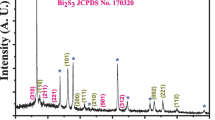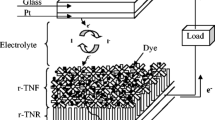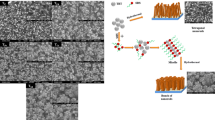Abstract
Hydrothermal process has been employed to synthesize titanium oxide (TiO2) bottle brush. The nanostructured bottle brushes with tetragonal nanorods of ~75 nm diameter have been synthesized by changing the nature of the precursors and hydrothermal processing parameters. The morphological features and structural properties of TiO2 films were investigated by field emission scanning electron microscopy, X-ray diffraction, high-resolution transmission electron spectroscopy, Fourier transform Raman spectroscopy, and X-ray photoelectron spectroscopy. The influence of such nanostructures on the performance of dye-sensitized solar cells (DSSCs) is investigated in detail. The interface and transient properties of these nanorods and bottle brush-based photoanodes in DSSCs were analyzed by electrochemical impedance spectroscopic measurements in order to understand the critical factors contributing to such high power conversion efficiency. Surface area of sample was recorded using Brunauer–Emmett–Teller measurements. It is found that bottle brush provides effective large surface area 89.34 m2 g−1 which is much higher than TiO2 nanorods 63.7 m2 g−1. Such effective surface area can facilitate the effective light harvesting, and hence improves the dye adsorption and the photovoltaic performance of DSSCs, typically in short-circuit photocurrent and power conversion efficiency. A best power conversion efficiency of 6.63 % has been achieved. We believe that the present device performance would have wide interests in dye-sensitized solar cell research.










Similar content being viewed by others
References
Chu SZ, Wada K, Inoue S, Hishita SI, Kura-shima K (2003) Fabrication and structural characteristics of ordered TiO2–Ru(–RuO2) nanorods in porous anodic alumina films on ITO/glass substrate. J Phys Chem B 107:10180–10184
Gong D, Grimes CA, Varghese OK, Hu W, Singh RS, Chen Z, Dickey EC (2001) Titanium oxide nanotube arrays prepared by anodic oxidation. J Mater Res 16:3331–3334
Guo W, Xu C, Wang X, Wang S, Pan C, Lin C, Wang ZL (2012) Rectangular bunched rutile TiO2 nanorod arrays grown on carbon fiber for Dye-sensitized solar cells. J Am Chem Soc 134:4437–4441
Kang SH, Kim JY, Kim Y, Kim HS, Sung YE (2007) Surface modification of stretched TiO2 nanotubes for solid-state dye-sensitized solar cells. J Phys Chem C 111:9614–9623
Kasuga T, Hiramatsu M, Hoson A, Niihara NTSK (1995) Titania nanotubes prepared by chemical processing. Adv Mater 11:1307–1311
Kumar A, Li K, Madaria AR, Zhou C (2011) Sensitization of hydrothermally grown single crystalline TiO2 nanowire array with CdSeS nanocrystals for photovoltaic applications. Nano Res 4:1181–1190
Law M, Greene LE, Johnson JC, Saykally R, Yang PD (2005) Nanowire dye-sensitized solar cell. Nat Mater 4:455–459
Liu B, Aydil ES (2009) Growth of oriented single-crystalline rutile TiO2 nanorods on transparent conducting substrates for dye-sensitized solar cells. J Am Chem Soc 131:3985–3990
Mali SS, Betty CA, Bhosale PN, Patil PS (2011) Hydrothermal synthesis of rutile TiO2 with hierarchical microspheres and their characterization. CrystEnggComm 13:6349–6351
Mali SS, Betty CA, Bhosale PN, Devan RS, Ma YR, Kolekar SS, Patil PS (2012a) Hydrothermal synthesis of rutile TiO2 nanoflowers using Brønsted acidic ionic liquid [BAIL]: synthesis, characterization and growth mechanism. CrystEngComm 14:1920–1924
Mali SS, Betty CA, Bhosale PN, Shinde PS, Pramod MR, Jadkar SR, Patil PS (2012b) Efficient dye-sensitized solar cells based on hierarchical rutile TiO2 microspheres. CrystEngComm 14:8156–8161
Mali SS, Kim HJ, Shim CS, Bae WR, Tarwal NL, Sadale SB, Patil PS, Kim JH, Hong CK (2013a) Single-step synthesis of 3D nanostructured TiO2 as a scattering layer for vertically aligned 1D nanorod photoanodes and their dye-sensitized solar cell properties. CrystEngComm 15:5660–5667
Mali SS, Kim HJ, Shim CS, Patil PS, Kim JH, Hong CK (2013b) Surfactant free most probable TiO2 nanostructures via hydrothermal and its dye sensitized solar cell properties. Sci Rep 3:3004. doi:10.1038/srep03004
Papageorgiou N, Liska P, Kay A, Gratzel M (1999) Mediator transport in multilayer nanocrystalline photoelectrochemical cell configurations. J Electrochem Soc 146:898–907
Pawar RC, Shaikh JS, Shinde PS, Patil PS (2011) Dye sensitized solar cells based on zinc oxide bottle brush. Mater Lett 65:2235–2237
Ren X, Gershon T, Iza DC, Munoz-Rojas D, Musselman K, MacManus-Driscoll JL (2009) The selective fabrication of large-area highly ordered TiO2 nanorod and nanotube arrays on conductive transparent substrates via sol–gel electrophoresis. Nanotechnology 20:365604
Sun Z, Kim JH, Liao T, Zhao Y, Bijarbooneh F, Malgras V, Dou SX (2012) Continually adjustable oriented 1D TiO2 nanostructure arrays with controlled growth of morphology and their application in dye-sensitized solar cells. CrystEngComm 14:5472–5478
Sun Z, Kim JH, Liao T, Zhao Y, Attard D, Dou SX (2013) Morphology-controllable 1D–3D nanostructured TiO2 bilayer photoanodes for dye-sensitized solar cells. Chem Commun 49:966–968
Usami A (1997) Theoretical study of application of multiple scattering of light to a dye-sensitized nanocrystalline photoelectrichemical cell. Chem Phys Lett 277:105–108
Wang M, Chen P, Humphry-Baker R, Zakeeruddin SM, Gratzel M (2009) The influence of charge transport and recombination on the performance of dye-sensitized solar cells. ChemPhysChem 10:290–299
Zaban A, Greenshtein M, Bisquert J (2003) Determination of the electron lifetime in nanocrystalline dye solar cells by open-circuit voltage decay measurements. ChemPhysChem 4:859–864
Acknowledgments
This research was supported by the Basic Science Research Program through the National Research Foundation of Korea (NRF) funded by the Ministry of Education (NRF-2009-0094055).
Author information
Authors and Affiliations
Corresponding authors
Rights and permissions
About this article
Cite this article
Mali, S.S., Patil, J.V., Kadam, P.M. et al. Hydrothermal synthesis of rutile TiO2 bottle brush for efficient dye-sensitized solar cells. J Nanopart Res 16, 2406 (2014). https://doi.org/10.1007/s11051-014-2406-2
Received:
Accepted:
Published:
DOI: https://doi.org/10.1007/s11051-014-2406-2




